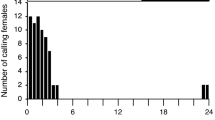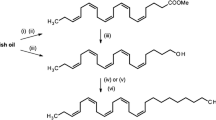Abstract
Female-emitted volatile sex pheromones in most moths are composed of biosynthetically related blends of fatty acid derivatives, such as aldehydes, acetate esters and alcohols. In many moths, as in the noctuid Heliothis (Chloridea) virescens, the pheromone gland contains alcohols (e.g., (Z)-11-hexadecen-1-ol, hereafter Z11–16:OH) that may serve dual functions as pheromone components as well as precursors of other pheromone components. The relative importance of Z11–16:OH to male attraction in H. virescens has been controversial. It occurs in the pheromone gland in relatively large amounts, but several studies could neither detect Z11–16:OH in gland emissions nor attribute any conspecific behavioral function to it in flight- tunnel assays. Trapping assays in the field, however, have more consistently documented that the addition of Z11–16:OH increased trap catch. Using a short section of thick film megabore column, in combination with derivatization and GC-CI-SIM-MS, we determined that Z11–16:OH is emitted from the sex pheromone gland during calling. Field trapping studies demonstrated that trap catch increased when Z11–16:OH was added to a 2-component minimal blend and to a 6-component blend. Behavioral observations in the field confirmed that more males responded to a pheromone blend that contained a low blend ratio of Z11–16:OH, but ≥5% Z11–16:OH depressed both male behavior and trap catch. We conclude that Z11–16:OH should be considered a component of the sex pheromone of H. virescens females.





Similar content being viewed by others
References
Allison JD, Cardé RT (2016a) Pheromone communication in moths: evolution, behavior, and application. Oakland. University of California Press, California, p 416
Allison JD, Cardé RT (2016b) Pheromones: reproductive isolation and evolution in moths. In: Allison JD, Cardé RT (eds) Pheromone communication in moths: evolution, behavior, and application. Oakland. University of California Press, California, pp 11–23
Choi MY, Groot A, Jurenka RA (2005) Pheromone biosynthetic pathways in the moths Heliothis subflexa and Heliothis virescens. Arch Insect Biochem Physiol 59:53–58
El-Sayed AM (2018) The Pherobase: Database of insect pheromones and semiochemicals. http://www.pherobase.com
Groot AT, Santangelo RG, Ricci E, Brownie C, Gould F, Schal C (2007) Differential attraction of Heliothis subflexa males to synthetic pheromone lures in eastern US and western Mexico. J Chem Ecol 33:353–368
Groot AT, Inglis O, Bowdrigde S, Santangelo RG, Blanco C, Lopez JD, Teran Vargas A, Gould F, Schal C (2009) Geographic and temporal variation in moth chemical communication. Evolution 63:1987–2003
Groot AT, Blanco CA, Classen A, Inglis O, Santangelo RG, Lopez J, Heckel DG, Schal C (2010) Variation in sexual communication of the tobacco budworm, Heliothis virescens. Southw Entomol 35:367–372
Groot AT, Schofl G, Inglis O, Donnerhacke S, Classen A, Schmalz A, Santangelo RG, Emerson J, Gould F, Schal C, Heckel DG (2014) Within-population variability in a moth sex pheromone blend: genetic basis and behavioural consequences. Proc R Soc B-Biol Sci 281:10
Hartstack AW Jr, Lopez JD, Klun JA, Witz JA, Shaver TN, Plimmer JR (1980) New trap designs and pheromone bait formulation for Heliothis. Proc Beltwide Cotton Prod Conf:132–135
Heath RR, Mitchell ER, Tovar JC (1990) Effect of release rate and ratio of (Z)-11-hexadecen-1-ol from synthetic pheromone blends on trap capture of Heliothis subflexa (Lepidoptera, Noctuidae). J Chem Ecol 16:1259–1268
Heath RR, McLaughlin JR, Proshold F, Teal PEA (1991) Periodicity of female sex pheromone titer and release in Heliothis subflexa and H. virescens (Lepidoptera, Noctuidae). Ann Entomol Soc Am 84:182–189
Hillier NK, Baker TC (2016) Pheromones of Heliothine moths. In: Allison JD, Cardé RT (eds) Pheromone communication in moths: evolution, behavior, and application. Oakland. University of California Press, California, pp 301–333
JMP Pro (2016) JMP Pro 13.1.0. Cary, NC, USA: SAS Institute
Jurenka R, Blomquist GJ, Schal C, and Tittiger C (2016) Biochemistry and molecular biology of pheromone production. pp. 705–751, in. Reference module in life sciences 2017: Elsevier
Klun JA, Plimmer JR, Bierl-Leonhardt BA, Sparks AN, Chapman OL (1979) Trace chemicals: the essence of sexual communication systems in Heliothis species. Science 204:1328–1330
Klun JA, Bierl-Leonhardt BA, Plimmer JR, Sparks AN, Primiani M, Chapman OL, Lepone G, Lee GH (1980) Sex pheromone chemistry of the female tobacco budworm moth, Heliothis virescens. J Chem Ecol 6:177–183
Kuenen LPS, Hicks MN (2015) Gas chromatography column as an ambient-temperature volatile trap. Entomol Exp Appl 154:35–44
Lievers R, Groot AT (2016) Disposable polydimethylsiloxane (PDMS)-coated fused silica optical fibers for sampling pheromones of moths. PLoS One 11:e0161138
Linn CE Jr, Campbell MG, Roelofs WL (1987) Pheromone components and active spaces: what do moths smell and where do they smell it? Science 237:650–652
Linn CE, Roelofs WL (1989) Response specificity of male moths to multicomponent pheromones. Chem Senses 14:421–437
Morse D, Meighen E (1987) Pheromone biosynthesis: enzymatic studies in Lepidoptera. Pp. 212-215. In: Prestwich GD, Blomquist GJ (eds) Pheromone biochemistry. Academic Press, New York
Nojima S, Apperson CS, Schal C (2008) A simple, convenient, and efficient preparative GC system that uses a short megabore capillary column as a trap. J Chem Ecol 34:418–428
Nojima S, Kiemle DJ, Webster FX, Apperson CS, Schal C (2011) Nanogram-scale preparation and NMR analysis for mass-limited small volatile compounds. PLoS One 6:e18178
Nojima S, Claβen A, Groot AT, and Schal C (2018) Qualitative and quantitative analysis of chemicals emitted from the pheromone gland of individual Heliothis subflexa females. PLoS eOne (in press)
Pope MM, Gaston LK, Baker TC (1982) Composition, quantification, and periodicity of sex pheromone gland volatiles from individual Heliothis virescens females. J Chem Ecol 8:1043–1055
R Core Team (2013) R: a language and environment for statistical computing. Vienna, Austria: R Foundation for statistical computing (http://www.R-project.org/)
Ramaswamy SB, Randle SA, Ma WK (1985) Field evaluation of the sex pheromone components of Heliothis virescens (Lepidoptera, Noctuidae) in cone traps. Env Entomol 14:293–296
Roelofs WL, Hill AS, Cardé RT, Baker TC (1974) Two sex pheromone components of tobacco budworm moth, Heliothis virescens. Life Sci 14:1555–1562
Shaver TN, Hendricks DE, Lopez JD (1989) Influence of (Z)-11-hexadecen-1-ol on field performance of Heliothis virescens pheromone in a PVC dispenser as evidenced by trap capture. J Chem Ecol 15:1637–1644
Suckling DM (2016) Monitoring for surveillance and management. In: Allison JD, Cardé RT (eds) Pheromone communication in moths: evolution, behavior, and application. Oakland. University of California Press, California, p 416
Teal PEA, Tumlinson JH (1986) Terminal steps in pheromone biosynthesis by Heliothis virescens and Heliothis zea. J Chem Ecol 12:353–366
Teal PEA, Tumlinson JH (1988) Properties of cuticular oxidases used for sex pheromone biosynthesis by Heliothis zea. J Chem Ecol 14:2131–2145
Teal PEA, Heath RR, Tumlinson JH, McLaughlin JR (1981) Identification of a sex pheromone of Heliothis subflexa (Gn) (Lepidoptera, Noctuidae) and field trapping studies using different blends of components. J Chem Ecol 7:1011–1022
Teal PEA, Tumlinson JH, Heath RR (1986) Chemical and behavioral analyses of volatile sex pheromone components released by calling Heliothis virescens (F) females (Lepidoptera, Noctuidae). J Chem Ecol 12:107–126
Tumlinson JH, Hendricks DE, Mitchell ER, Doolittle RE, Brennan MM (1975) Isolation, identification, and synthesis of the sex pheromone of the tobacco budworm. J Chem Ecol 1:203–214
Vetter RS, Baker TC (1983) Behavioral responses of male Heliothis virescens in a sustained flight tunnel to combinations of 7 compounds identified from female sex pheromone glands. J Chem Ecol 9:747–759
Vickers NJ, Christensen TA, Mustaparta H, Baker TC (1991) Chemical communication in heliothine moths. 3. Flight behavior of male Helicoverpa zea and Heliothis virescens in response to varying ratios of intraspecific and interspecific sex-pheromone components. J Comp Physiol A Neuroethol Sens Neural Behav Physiol 169:275–280
Witzgall P, Kirsch P, Cork A (2010) Sex pheromones and their impact on pest management. J Chem Ecol 36:80–100
Wood SN (2011) Fast stable restricted maximum likelihood and marginal likelihood estimation of semiparametric generalized linear models. J R Stat Soc B 73:3–36
Acknowledgements
We are grateful to Cathy Herring (Central Crops Research Station, Clayton, NC) for maintenance of the field plots. This research was supported in part by the National Science Foundation (award IOS-1456973), the Netherlands Organisation for Scientific Research (NWO-ALW, award 822.01.012 and ALWOP 2015.075), the W.M. Keck Center for Behavioral Biology, the Max Planck Society, and the Blanton J. Whitmire Endowment at North Carolina State University. BA’s visit to North Carolina State University was supported by the Spanish Ministry of Science and Innovation (EEBB-C-14-00465).
Author information
Authors and Affiliations
Corresponding authors
Additional information
Astrid T. Groot and Satoshi Nojima shared co-first authorship.
Rights and permissions
About this article
Cite this article
Groot, A.T., Nojima, S., Heath, J.J. et al. Alcohol Contributes to Attraction of Heliothis (= Chloridea) virescens Males to Females. J Chem Ecol 44, 621–630 (2018). https://doi.org/10.1007/s10886-018-0995-4
Received:
Revised:
Accepted:
Published:
Issue Date:
DOI: https://doi.org/10.1007/s10886-018-0995-4




